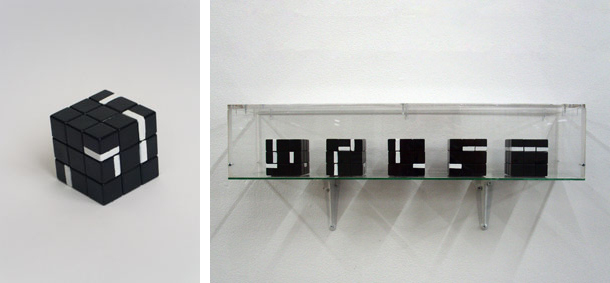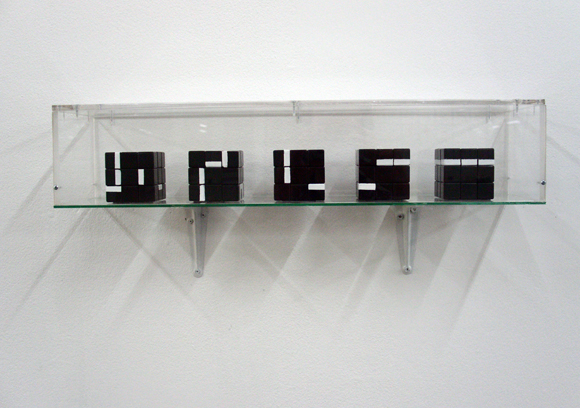| |
|
|
09.
| Brainteaser for moderate muslim |
| |


2004, acrylic on rubiks cubes, 54 x 11,5 x 13,5 cm.
Exhibition view from Traces du sacré, Haus der Kunst, 2008, Münich.
Courtesy of the artist and BARO galeria, Palma.
Ed. of 5 + 1 A.P.
'' The title suggests a playful reference to The Kaaba, a pre-Islamic monument rededicated by the prophet Muhammad,
while the work as a whole invites critical thinking, with tones of political reflection. ''
Elena Stanciu, PETRIe Magazine, 2016

Brainteaser for moderate muslim
Courtesy of the artist.

Brainteaser for moderate muslim
Exhibition view from Traces du sacré, Haus der Kunst, 2008, Münich.
Courtesy of the artist.
|
|
|
|
|
| Collection of Nadour, Krefeld
Collection of a/political, London
Casse-tête pour un musulman modéré est une série de sculptures inspirées du célèbre jeu de logique Rubik's cube. L'œuvre s'inscrit dans un travail initié en 2004 avec la vidéo Manipulations et se poursuivant avec une série de photographies, une sculpture et finalement un jeu. Les jeux mis au point par Mounir Fatmi se composent de cubes à facettes noires, à l'exception d'une rangée de cubes portant un trait blanc sur une de leur face. La série de sculptures met en scène des Rubik's cubes identiques à différents stades de leur résolution, jusqu'à l'étape finale, qui fait apparaître une bande blanche continue sur la rangée supérieure.
L'œuvre examine les rapports du croyant à un objet cultuel. Elle questionne le rapport de ce dernier aux dogmes et aux rituels de sa religion. Casse-tête pour un musulman modéré étudie le geste rituel accompli par le croyant lors du pèlerinage à la Mecque, à savoir la circumambulation autour de la Kaaba (littéralement le "cube"). Chaque sculpture se propose comme la représentation du monument cultuel (la Kaaba), dont elle reprend la couleur noire et l'ornementation de la partie supérieure du cube par une frise calligraphique exprimant la profession de foi musulmane. Mounir Fatmi compare ainsi, d'une façon qui peut sembler humoristique, ironique, voire même paradoxale, la profession de foi irrationnelle du croyant effectuant des cercles autour du cube de la Mecque, aux stratégies rationnelles, logiques et mathématiques du joueur tentant de résoudre le Rubik's cube.
L'objet de culte se voit transformé en jeu de décodage où la raison intervient à nouveau et invite alors à une approche scientifique du divin. Plutôt que de faire tourner aveuglément et à l'infini le cube, et de tenter en vain d'épuiser les combinaisons possibles afin de rétablir un ordre, le casse-tête invite peut être à développer une stratégie fondée sur l'usage de la raison. Le titre de l'œuvre souligne la difficulté pour le croyant dit "modéré" - qui se réserve une distance critique par rapport aux dogmes de sa religion - à considérer de manière rationnelle l'objet de culte et le rituel qui lui est associé. La circumambulation autour de la Kaaba suppose un geste et une attitude irrationnelles du croyant. Elle suggère à celui-ci d'abandonner la réflexion et d'agir avec dévotion. L'œuvre exprime quant à elle la difficulté pour la raison d'appréhender l'objet de culte et le rituel, difficulté envisagée à son tour comme un problème à résoudre. Avec Casse-tête pour un musulman modéré, Mounir Fatmi tente d'aborder un phénomène d'une grande complexité avec les moyens limité de l'art. Le recours aux techniques inspirées du minimalisme permet finalement une approche de la complexité avec un minimum de moyens : à l'aide d'une forme géométrique simple et limitée, il réalise la description d'un univers de probabilités approchant l'infini.
S'affrontant à la création, les sculptures dressent ici un portrait de l'artiste en être libre de faire des choix et en concurrent de Dieu lui-même. Exposée derrière une vitrine, figée au sein d'un dispositif muséal et soustraite aux éventuelles manipulations des spectateurs, l'œuvre indique également le moment précis où l'objet quitte son statut ludique et interactif pour devenir une œuvre d'art soumise à l'attention d'observateurs passifs. Elle illustre enfin de quelle manière la démarche artistique s'apparente à un jeu consistant à opérer une sélection parmi un univers de possibilités quasiment infinies.
Studio Fatmi, Juillet 2017.
|
|
Brainteaser for a moderate Muslim is a series of sculptures inspired by the famous game of logic Rubik’s Cube. The piece is part of a larger body of work initiated in 2004 with the video Manipulations and continued with a series of photographs, a sculpture and finally a game. The games created by Mounir Fatmi are composed of cubes with black faces, with the exception of one row of cubes with a white line on their faces. The series of sculptures shows identical Rubik’s cubes in various stages of completion, until the final step, where a continuous white line appears on the upper row.
Brainteaser for moderate Muslim looks at the relation of a believer to an object of worship. The work questions his or her relation to religious dogma and rituals. It studies the ritual gesture accomplished by the believer during the pilgrimage to Mecca, namely the circumambulation around the Kaaba (literally the “cube”). The logical game is conceived as a representation of the monument of worship (the Kaaba), emulating its black color and ornamentation on its superior section by a calligraphic frieze expressing the Muslim profession of faith. In this way, Mounir Fatmi compares, with what can be perceived as humor or even irony, the irrational profession of faith of a believer walking in circles around the cube in Mecca with the rational, logical and mathematic strategies of a player trying to solve a Rubik’s Cube.
The object of worship is transformed into a deciphering game where reason is present again, encouraging a scientific approach to the divine. Rather than to blindly and endlessly rotate the cube in a vain attempt to try every possible combination to restore an order, perhaps the brainteaser invites the viewer to develop a strategy based on the use of reason. The title of the work highlights the difficulty for a so-called “moderate” believer – who authorizes himself a certain critical distance with the dogma of his religion – to consider in a rational way the object of worship and the ritual associated with it. The circumambulation around the Kaaba requires an irrational gesture and attitude on the part of the believer. It pushes him to dismiss thought and to act with devotion. As for the work of art, it expresses the difficulty for reason to apprehend the object of worship and the ritual, a difficulty that is also seen as a problem that needs solving. With Brainteaser for moderate Muslim, Mounir Fatmi tries to tackle an extremely complex phenomenon with the limited means of art. Resorting to techniques inspired by minimalism enables him approach complexity with limited means: with a simple and limited geometric shape, he realizes the description of a universe of probabilities that touches on infinity.
Tackling the subject of creation, these sculptures show the artist as an individual who is free to make choices and in competition with God himself. Exposed behind a window, frozen within a museum configuration and shielded from any manipulations by the viewers, the work of art also indicates the precise moment when the object sheds its playful and interactive properties to become artwork subjected to the attention of passive observers. Finally, it illustrates how artistic propositions are akin to a game that would consist in making a selection among a practically infinite universe of possibilities.
Studio Fatmi, July 2017.
|
|
|
|